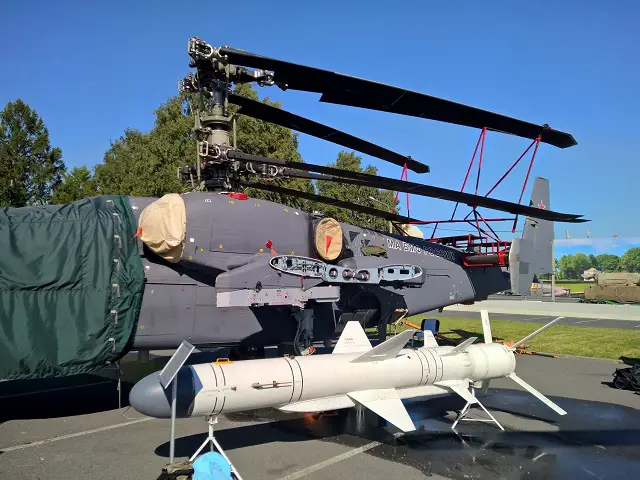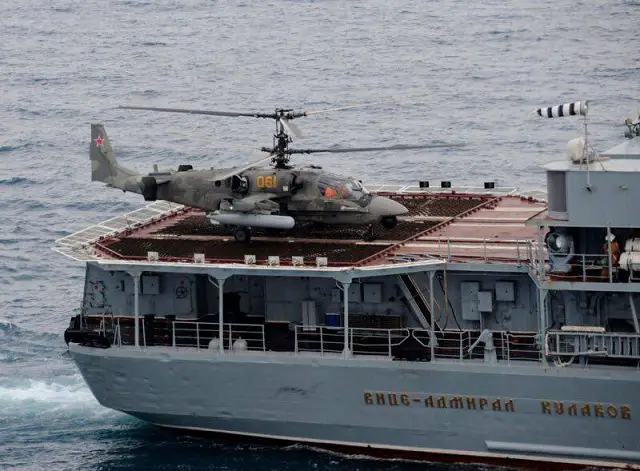Analysis: Ka-52K Katran Naval Helicopter Passes First Set of Maritime Trials
|
|
|||
|
Video: Ka-52K Katran naval helicopter on the deck of the carrier Admiral Kuznetsov during its Syrian mission
|
|||
|
|
|||
| The Russian Helicopters’ report does not specify the warships and regions where the sea trials of the Ka-52K were conducted. However, it is known that the cruise to the shores of Syria allowed the crew of the heavy aircraft-carrying cruiser Admiral Kuznetsov to test new aircraft. This was reported to President of the Russian Federation Vladimir Putin by commander of the ship Sergei Artamonov at a meeting of the head of state with the military seamen. The commander of the cruiser said, in particular, that "the newest deck-based helicopter Ka-52K was tested during the cruise and met the expectations placed on it." The Ka-52K helicopter is a continuation of the line of ship-based helicopters adopted by the Russian Navy. This line includes the Ka-25, Ka-27, Ka-29, Ka-31 helicopters. The Ka-52K helicopter is designed for patrolling, fire support of amphibious troops during landing, performing anti-landing defense missions at the forefront and in tactical depth. A modern avionics system provides the helicopter with navigation in the absence of landmarks at sea. The Ka-52K differs from the baseline model in a shortened folding wing, which was modified to accommodate heavy weapons, including the Kh-35, Kh-38 anti-ship missiles, and a blade folding mechanism that allows it to be compactly placed in the hold of the ship. The smaller dimensions of the Ka-52K helicopters make it possible to increase the number of vehicles deployed on the ship. The armored crew cockpit and a rescue ejection system allow the pilots to safely abandon the helicopter. In addition, the Ka-52 ship-based helicopter is provided with a rescue kit which helps rescue people who are in distress at sea. The design of the Ka-52K uses corrosion-resistant materials due to the need for the helicopter to operate in a humid marine climate. The helicopter is fitted with a centralized refueling system and a modernized air conditioning system that provides ventilation for the crewmember marine rescue suits. In addition, the helicopter carries a radio navigation system, which was not used on the baseline model. In 2015, it became known that the Ka-52K helicopters, which are being built by the Arseniev Progress Aircraft Plant, can be upgraded later to perform a wider range of missions at sea. Initially, the Ka-52K helicopters were equipped with the Arbalet onboard radar developed by Fazotron-NIIR for the Ka-52 land version. The radar developer proposed to expand the performance of the ship-based version of the helicopter by equipping it with an upgraded radar with a built-in centimeter frequency range, which will increase the detection range to almost 200 km and provide the possibility of using Kh-31 and Kh-35 anti-ship missiles. |
|||
|
|
|||
 Ka-52K prototype on display during IMDS 2015 with its rotors and wings folded. Note the Kh-35 anti-ship missile next to it. Picture: via bmpd.livejournal.com Ka-52K prototype on display during IMDS 2015 with its rotors and wings folded. Note the Kh-35 anti-ship missile next to it. Picture: via bmpd.livejournal.com |
|||
|
|
|||
| The Ka-52-based helicopters are being modified for use in the Arctic. This was announced at the MAKS 2015 Air Show by Kamov CEO Sergey Mikheev. According to him, the Arctic version of the Ka-52 army helicopter will introduce a number of improvements developed in the course of work on the ship-based version of the helicopter. Among them are "an extensive electronic system, a blade folding system and other innovations," Mikheev noted. "They (innovations) aim to ensure that this vehicle is actively used in Arctic groups," he said. Along with the Ka-52, the ship-based version of the Ka-52K will also be in demand in the Arctic. The Russian defense industry is actively engaged in upgrading radar equipment for the Ka-52K deck-based helicopters. This was announced in October 2015 by Andrey Shibitov, Russian Helicopters Deputy CEO for Production. In August 2016, the Ka-52K helicopters began flights from the deck of the heavy aircraft-carrying cruiser Admiral Kuznetsov. By the end of 2016, Russian Helicopters was to deliver four prototype Ka-52K helicopters for testing, Alexander Scherbinin, Deputy CEO for Marketing and Business Development, said in an interview with TASS. Tests of the new Ka-52K ship-based helicopters were already under way on the Russian Navy’s aircraft-carrying ships, the press service of Russian Helicopters reported in October 2016. The holding company did not specify which ships were used for tests and when they would be completed, but noted that "Russian test pilots were favorably impressed by this helicopter." |
|||
|
|
|||
 The navalised version of the Alligator features a folding rotor head and folding stub-wings. Image: Kamov The navalised version of the Alligator features a folding rotor head and folding stub-wings. Image: Kamov |
|||
|
|
|||
| In March 2017, Deputy Defense Minister Yury Borisov, when visiting the Progress Plant, acknowledged the existence of certain problems with the Ka-52K ship-based helicopter, but he expressed confidence that they would be resolved as soon as possible. "We discussed the problems with the Ka-52K helicopter. We have completed all preliminary tests of this ship-based helicopter and we need to decide on the ships from which it will operate," the deputy defense minister said. In accordance with the existing program for the modernization and renewal of the Navy’s maritime aircraft fleet, about 100 new aircraft will be fielded to the naval aviation units by 2020. The newest Ka-52K reconnaissance and strike deck-based helicopters will begin to replace the Ka-29 helicopters currently in service. At present, a number of R&D projects are being carried out on the instruction of the Main Command of the Navy to develop fundamentally new aircraft, unmanned aerial vehicles and airborne weapons. The need for further development and equipping of naval aviation with new aircraft was confirmed once again during the long-range cruise of the Russian Navy’s naval aircraft carrier group to the Mediterranean between October 2016 and February 2017. Then the aircraft-carrying cruiser Admiral Kuznetsov’s air wing, which includes the Su-33, MiG-29K aircraft, Ka-52K, Ka-27PL, Ka-27PS, Ka-29 deck-based helicopters, fulfilled the whole range of assigned missions in the airspace over the sea and land, the Russian Ministry of Defense told. © Copyright 2017 TASS. All rights reserved. This material may not be published, broadcast, rewritten or redistributed. |
|||



























